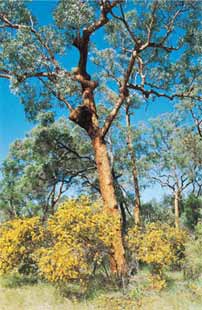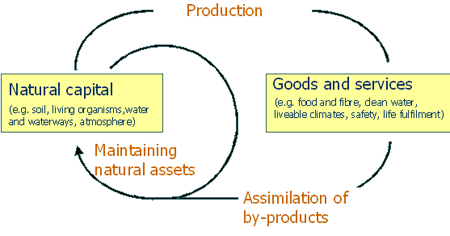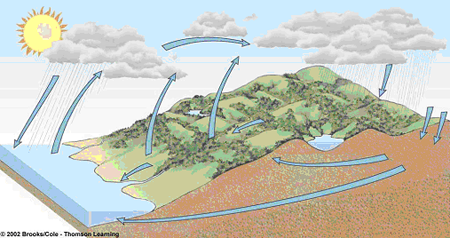Topic 1.1 Ecosystem Services
Module aims
In this module, we will:
- define natural capital and ecosystem services
- discuss the production of ecosystem goods and services
- briefly discuss the valuation of ecosystem services
- explore the causes and consequences of loosing ecosystem services
- introduce the links between ecosystem services and the two major themes in this course, i.e., ‘Population and Consumption’, and ‘Population and Environmental Impact’.
The information in this module will be repeatedly referred to throughout this course and we will specifically come back to ecosystem services (ESS) and their role in natural resource management in the final module.
![]()
Introduction
Despite our ingenuity and development of technology, humans are totally reliant on the world’s ecosystems to provide oxygenated air, clean water, food, fiber for clothing, and raw materials for both building and producing medicines.
All life and economies depend on energy from the sun (solar capital) and the earth's resources and ecosystem services (collectively termed natural capital).
Consider Miller & Spoolman (2009), Figure 1-3 on Page 8. This figure shows the Earth's natural capital, which consists of resources such as air and soil and ecosystem services or natural services, which consists of processes such as nutrient and water cycling.
Ecosystem services are naturally produced by healthy ecosystems. The concept of ecosystem services evolved out of a union between the disciplines of ecology and economics. Much of the research into ecosystem services is based on determining their economic value, in order to use and manage ecosystems and their products more sustainably and effectively. Throughout this unit we will consider human use of, and impact on, natural capital and ecosystem services.
What are Ecosystem Services?
Considerable attention has been given to the concept of ecosystem services (ESS) by ecologists and economists over the last decade as we’ve developed a greater understanding of how important our ecosystems are and the need to interact sustainably with our environment.
Definition of Ecosystem Services
 Ecosystem services have formally been defined as "…the conditions and processes by which natural ecosystems, and the species that make them up, sustain and fulfill human life" (Daily, 1999).
Ecosystem services have formally been defined as "…the conditions and processes by which natural ecosystems, and the species that make them up, sustain and fulfill human life" (Daily, 1999).
What this means is that ecosystems and their natural processes (e.g., photosynthesis, pollination, decomposition of dead organisms, soil formation from weather rock and organic matter) provide benefits for humans and without these benefits we would not be able to inhabit the earth.
You may have noticed that Daily's definition of ecosystem services specifically refers to the services derived from natural ecosystems where humans have had minimal impact. However we also receive benefits from human made and human altered ecosystems (e.g., agricultural land, urban parks). In more technical terms the "natural" biotic, chemical and physical processes of agricultural-ecosystems and urban-ecosystems are also important in providing ecosystem services to sustain human life.
Expanded Definition of Ecosystem Services
Therefore a more useful definition of ecosystem services is that they are the conditions and processes by which all ecosystems, and the species and other parts that make up ecosystems, sustain and fulfill human life.
Thus the concept of ecosystem services is human centred (anthropocentric) and provides a way of understanding how important ecosystems and the ways they work are for supporting life and providing for human needs. We need to understand how ecosystems work so that we don’t negatively affect these processes.
Therefore by considering ecosystem services we will have a better understanding of the relationship between humans and their environment (i.e. our dependence on ecosystems, particularly natural ecosystems) and ultimately be able to manage our natural resources more sustainably. At this stage you will most probably be unsure how an understanding of ecosystem services will be able to direct natural resource management in this way. We will reflect back on this statement at the end of this module and in the final module of this course and see how your response to this statement may have changed.
![]()
Activity 1.1
Read page 1 of the Ecosystem Services Fact Sheet ![]() web site and answer these questions:
web site and answer these questions:
- What are ecosystems?
- Using the above information and the ESS fact sheet define ecosystem services in the way you think is most useful for explaining what they are to other people?
- With reference to both the information given in this section and additional resources, make a list of five (5) ecosystem services giving a brief definition of each service. We've started here with two examples.
| Ecosystem Services | Definition |
| Gas regulation | Regulation of the earth?s atmosphere to maintain it?s chemical composition suitable for human life |
| Natural Pest Control | Regulation of population size by other organisms (i.e. natural enemies such as predators, parasites and pathogens) or by climatic variables and landscape characteristics that restrict population growth |
![]()
Why is the Concept of Ecosystem Services Important?
The concept of ecosystem services is important for many reasons including:
- Humans rely on ecosystem services.
- Ecosystems provide these services when they are working well.
- Most ecosystem services are greatly undervalued by society because they are considered "free" and inexhaustible, i.e., we don't have formal markets to buy and sell most ESS.
- This lack of awareness of the value of ecosystems helps drive the conversion of natural ecosystems into other systems that produce marketable goods (e.g., by clearing a forest to sell the timber, converting bushland to cropland) thereby disrupting or deminishing the ecosystem processes (e.g., clearing forests reduces carbon storage, reduces soil protection from the erosive impact of rain or overland flow).
- Current trends suggest that we are in the process of dramatically altering our ecosystems and that these changes could have severely detrimental effects on the future provision of ESS and our quality of life.
The Production of Ecosystem Services
As mentioned above ecosystem services are the outcome of the natural processes of ecosystems (e.g., pollination, rain formation, photosynthesis). That is, in the process of living, growing and changing, all the different parts that make up ecosystems provide the essential elements needed to support and sustain human life (e.g., air, water, food, shelter).
For example, soil might be considered to have six categories of ecosystem services.
- Buffering and moderation of the hydrological (i.e. water) cycle
- Physical support of plants
- Nutrient supply to plants
- Disposal of waste and dead organic matter
- Renewal of soil fertility
- Regulation of major elemental cycles (e.g. the nitrogen cycle)
![]()
Activity 1.2
Spend some time now considering Figure 1 and click on each of the diagram labels for further information.
Figure 1. Ecosystem Services are produced by Transformations of Natural Capital

(For definitions used in the above diagram, please Click on Figure 1 Definitions )
Natural capital produces ecological goods and services
Natural capital is the stock of all the elements of ecosystems (e.g a forest system) that produce a flow of goods (e.g trees) and services (e.g carbon storage, erosion control; habitat).
Natural capital provides the raw material for life and for human activities such as manufacturing, agriculture and recreation (refer to Miller & Spoolman (2009), page 8 and Figure 1-3).
The term natural capital is derived from the economics concept that equates the natural capital of ecosystems with the highly valued capital of economic systems. Capital is considered to be a stock of materials or information that exists at a point in time and can be used to generate, by itself, or in conjunction with services from other capital, a flow of services that benefits the well being of humans into the future.
- For example, raw material capital + human capital + $ = manufactured product.
Therefore natural capital can be considered as a stock from which ecosystem services flow and the processes of ecosystems are the procedures or methods used to create the flow of services. Refer to Figure 1 for a diagrammatic representation of how the "flow" of ecosystem services are produced.
In summary, parts of ecosystems have been defined as "natural capital" so that they can be considered and accounted as valuable capital like other forms of capital such as financial capital or human capital.
![]()
Activity 1.3
Q1. Return to the list of ecosystem services you produced to answer Q3 in Activity 1.1 and add to the definition of each service a brief description of how the service is produced (i.e., what parts of the ecosystem for example species, soil, water, atmosphere etc. are involved and what processes are at work). You could use the following table:
| Ecosystem Service |
Description | How the service is produced |
| Natural Pest Control |
Regulation of population size by other organisms (i.e. natural enemies such as predators, parasites and pathogens) or by climatic variables and landscape characteristics that restrict population growth | Organisms feeding on or in otherways increasing the death or reducing the reproduction of a species or by elements of climate or landscape structure increasing the death or reducing the reproduction of a species |
![]()
Biodiversity - an important form of Natural Capital
Biodiversity is an important form of natural capital and plays a vital role in the production of ecosystem services through its role in ecosystem processes
Biological diversity or biodiversity includes the variety of different species (species diversity), genetic variability among individuals within each species (genetic diversity), variety of ecosystems (ecological diversity) and functions or processes such as energy flow and matter cycling needed for the survival of species and biological communities (functional diversity).
However, biodiversity is often equated to species diversity (i.e., the number of different species), and other components of biodiversity have received far less attention in scientific literature until recently.
Biodiversity and Ecosystem Processes
A major area of ecological research involving biodiversity conservation is based on looking for possible connections between species diversity and how well ecosystems are able to perform the various ecosystem processes.
As we discussed above biodiversity is an important part of natural capital. However, for the production of ecosystem services it is more important that there are enough of the appropriate species to perform different roles in the system (for example, enough plants to capture energy and create biomass, enough decomposers to breakdown waste products etc.). Therefore in terms of ecosystem services it is more important to conserve species that perform each of the ecosystem processes than it is to conserve any one specific species. For example if we were able to identify the level of biodiversity or specific species required by an ecosystem to function sufficiently to produce the desired ESS we would be able to value and conserve the appropriate level of biodiversity. [Think about some of the problems with this approach to biodiversity conservation, e.g., lack of knowledge, the precautionary principle, preservation of options, the intrinsic value of species].
A NOTE TO ECOLOGY STUDENTS:
You may have come across the concept of the functional role of species and functional diversity. This concept is based on the fact that the functional role of species (i.e. what each species does in the ecosystem) and having enough of the right species to complete each of the roles, is actually more important for the process of ecosystems and provision of ESS than the numbers of species in the ecosystem. To date research in this area has focused on plant communities rather than the full array of biotic organisms.
Loss of Biodiversity
Due primarily to human interventions, particularly land clearing, habitat alteration and the intentional or accidental introduction of exotic species, large numbers of species have become extinct, approximately 1,033 in the last 400 or so years (Lomborg 2001). These numbers are much lower than the estimated numbers thought to have become extinct during the mass extinctions 245 million and 65 million years ago. Half of all marine animals and four legged vertebrates and two thirds of all insects are thought to have been wiped out 245 million years ago.
However, the major difference between mass extinctions in the past and current concerns about species loss is the role humans have in the process.
![]()
Interactions Between Ecosystem Services
Ecosystem services are linked and NO SERVICE ACTS IN ISOLATION. This is largely because the same populations of species, geological elements and other components of natural capital are involved in multiple ecosystem functions and therefore a number of different ESS.
![]()
Activity 1.4
Miller & Spoolman (2009), page 66 and Fig 3-17 describes the hydrological cycle as a cycle of natural renewal of water quality. Consider the components of this environment and the multiple ways that each provides ecosystem services. For example, the atmosphere forms clouds from the water cycle in the hydrological cycle, and it also acts as a nitrogen sink in the nitrogen cycle, and is involved in climate regulation. Refer also to Fig 3-18, 3-19, 3-21, 3-22
List at least four other ecosystem services provided by the oceans and the vegetation in the figure below.

NOTE: The tutorial in Week 1 will be based on producing diagrams that illustrate how ecosystem services work. For more information refer to the information on tutorials and preparation. A summary of the discussion will be posted on the web site for external students.
![]()
Valuation of Ecosystem Services
Additional Readings
ESS valuation has become a central theme in ecosystem services science with increasing efforts to incorporate consideration of maintaining ESS into environmental policy decisions.
Why Value Ecosystem Services?
Activity 1.5
Read
- "Valuation of ecosystem services"

- Ecosystem Services Factsheet

- Miller, page 571. Spotlight box "What is the Economic value of the earth's ecological services?"
and answer the following:
- State 4 main reasons for the need to value ecosystem services?
- In a table list three advantatges and disadvantages of attempting to value ESS.
- Read Miller, page 204. What was the economic value given to the Earth's natural ecosystems. For those interested in this work, refer to the paper in the e-reserve by Costanza et al. 1997. The Web Links folder includes references about this work.
The Development of Markets for Ecosystem Services
One of the main ways proposed to successfully incorporate ecosystem services into decision making is to develop markets to value and trade these services.
We will return to this issue in the final module, for now refer to the Stanford University article 'Finding a market for 'ecosystem services' for an overview.
![]()
Causes and Consequences of Losing Ecosystem Services
Despite human reliance on ecosystems and the services they provide many of our interactions with our environment can damage ecosystems and impair the services they provide.
![]()
Activity 1.6
Read the following short Web articles / article sections and any additional information you find and answer the following questions.
“Threats to Ecosystem Services” ![]() "Ecosystems Services: Benefits Provided to Human Societies by Natural Ecosystems" Daily et al. located on the Sierra Forest Legacy website
"Ecosystems Services: Benefits Provided to Human Societies by Natural Ecosystems" Daily et al. located on the Sierra Forest Legacy website
"How are Ecosystem Services Cut-Off" ![]() section of Ecosystem Services Factsheet
section of Ecosystem Services Factsheet
- What are the two broad underlying forces driving human induced threats to ecosystem services?
- Think of some ways that the effects of these two main forces could be reduced or produce a beneficial rather than detrimental effect on ecosystems.
- List as many human activities as you can think of that disrupt, impair or reengineer ecosystems.
- Think of some specific ways that the impact of these activities could also be reduced.
It is important to stress at this point that although some of the negative impacts that humans have on the environment seem inevitable and irreversible, the functioning of many ecosystems could be restored if appropriate actions were taken. We will refer back to the point in the final module with a number of case studies.
The Link to Population Growth and Resource Consumption
1. Ecosystem Services: Population and Resource Consumption
Ecosystem services are essential for providing the basic needs of human populations as well as the "wants" and desired level of consumption.
Levels of human consumption, waste production and population growth have dramatic effects on ecosystems and their ability to provide ecosystem services
These two issues will be discussed further in the module on "Population and Consumption"
2.Ecosystem Services: Population and Environmental Impact
As a result of present patterns and means of consumption human populations have had significant effects on virtually all ecosystems on earth.
Many of these impacts have produced or are producing detrimental effects and environmental problems or issues. However, understanding the vital role of ecosystems, and the species they contain, in providing ecosystem services can point the way forward to achieving ecologically sustainable development.
These concepts will be discussed for a number of key environmental issues during the bulk of this course, Weeks 4-10.
![]()
Review Questions
Q1. Write your own definition of how ecosystem services are produced using a diagram (Figure 1 in Activity 1.2, or one of your own).
Q2. Should we put a price on nature's services? Explain. What are the alternatives?
Q3. Discuss the statement "By considering ecosystem services we will have a better understanding of the relationship between humans and their environment (i.e., our dependence on ecosystems, particularly natural ecosystems) and ultimately be able to manage our natural resources more sustainably".
![]()
